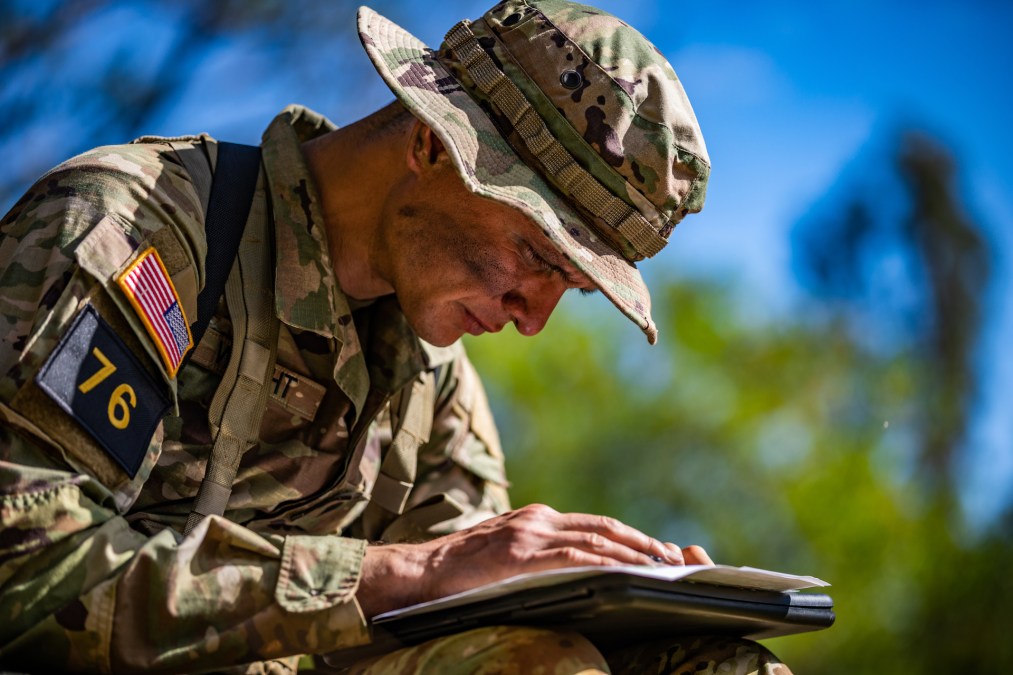AI startup wants to give troops the power of career intel professionals

An artificial intelligence startup wants to give troops on the ground the power of experienced intelligence analysts.
Danti provides an AI-powered knowledge engine for globally generated data that enables users to ask questions using natural language. The two-year old company has already been working with military and intelligence community customers such as the Space Force and National Geospatial-Intelligence Agency.
Designed for both career intelligence analysts and laypersons, the system allows users to ask a general question or do a deep dive on a topic by correlating data streams from public and private data. For example, a user could ask about ships in a certain area, and culled mapping data or exquisitely collected information can pinpoint vessels in the queried region. An analyst can then zoom in to get more info.
Additionally, users can query about hotspots, and the technology can point to social media posts that are also correlated to physical locations where events are happening, providing greater context to understand what’s going on.
The company’s founders wanted to build a knowledge engine specifically tuned for information tied to physical places. Much of the other large-scale data systems that exist are focused on unstructured text documents and records, but those don’t typically work for live intelligence feeds for understanding things that have a physical place in the world, such as maritime ship beacons, Jesse Kallman, Danti CEO and founder, said in an interview.
“We wanted to build something that would allow an analyst of any skill level, in a very conversational way, to ask questions of very highly distributed but also very multi-modal data,” he said.
“In the era of the Great Power Competition, information warfare is a most critical component. While our adversaries can throw people at the data overload and skilled workforce problem, we must use AI. Danti’s knowledge engine for information generated across our planet takes a deployed service member with no intel experience and gives them the power of a 15-year GEOINT analyst,” Kallman stated in a press release.
On the fast-paced battlefields of the future — where if forces stop for even a few minutes, they are vulnerable of being discovered and attacked — units are going to need quick access to information and intelligence without necessarily having to call back to a headquarters element.
“There are certain things that you just may not have time to reach back to your intel cell or back to headquarters, or back to an IC agency and wait a day or so, or even hours … to get that report, get that document or PowerPoint presentation in your hand. Maybe you need something now and this system can get you 80 percent of the way in 15 seconds,” he said. “How do you get information to the people who need it as fast as possible and then the experts can come in with that extra 10 to 15 percent with that much more significant level of depth if that particular use case warrants it.”
That fast-paced nature that’s anticipated for future warfare is “100 percent” why the company is putting forward the technology, Kallman said.
While most of the customers right now are at headquarters levels, the system is designed to be deployed to edge systems on simple devices such as mobile phones with limited compute power.
While novice, non-intel users are a big target for use, Kallman noted that it can also aid career intel analysts as they can dig much deeper and much faster than they’ve been used to.
The market is changing to more all-source intelligence rather than just singular modes such as image intelligence or signals intelligence, he said.
“There’s obviously GEOINT specialists and SIGINT specialists, but the vast majority of problem sets that people are working are all-source in nature. We want to absolutely make it easier for the expert, for example, that GEOINT expert, to do a way faster initial sourcing so they can get into the deep analysis,” he said. “It speeds up the highly expert analyst, but then I think it makes more folks more capable at the all-source level as well.”
Space Force customers have noted how the system facilitates their daily processes.
“Danti aids our mission to rapidly understand the massive volume of information, both in archive and newly generated, across commercial and open data sources,” Maj. Zach He, who works on the Tactical Surveillance, Reconnaissance and Tracking Program, stated in a press release. “Danti breaks down plain text questions into relevant and related components across the compiled data sources, creating a comprehensive, data rich, geographically anchored picture of information that TacSRT leverages to deliver analytical reports to our Space Force Components at our Combatant Commands.“
The system can run on unclassified systems as sell as classified networks, on-premise systems, edge nodes GovCloud and even the top secret networks of the military.
In early March, Danti announced its public sector offering, which will allow any government agency to access the capability.
“We’ve gotten to the point now where the system is in live, daily use across many different agencies. We want to make sure that we’re able to service this to the broader market and understand this is not [just] an NGA tool, it’s not [just] a Space Force tool, it’s not [just] a GEOINT tool, it’s not [just] a SIGINT tool,” Kallman said. “What are the kinds of questions you’re trying to accomplish and the mission you’re trying to accomplish? And how do we help you break down that data silo problem? … This problem is not unique to the DOD or IC. It’s in civil agencies. It’s everywhere. How do we provide more exposure and understanding for folks and say, like, ‘oh, I have this problem as well, but my mix of data is here.’ That’s what we’re really doing here, is just trying to make the system more available to more organizations.”






